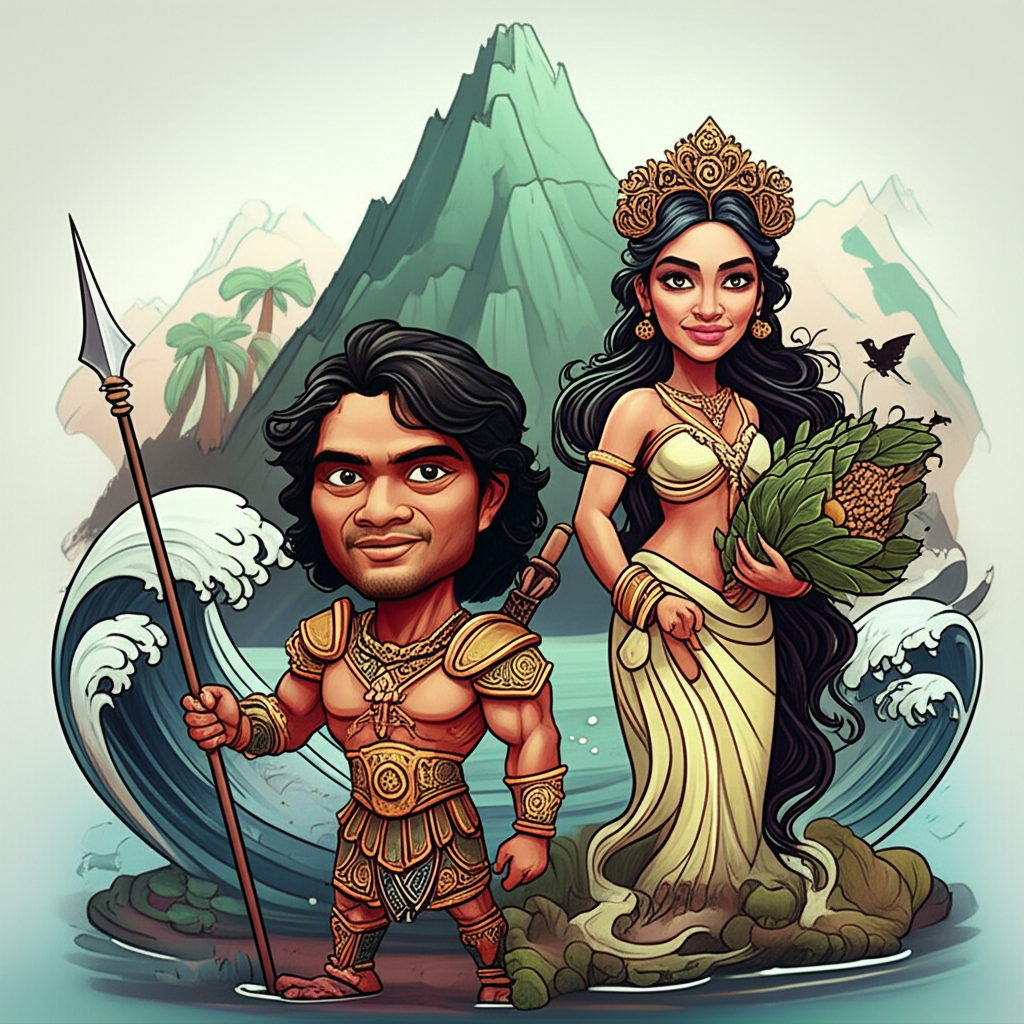
The rich tapestry of Filipino mythology is woven with tales of powerful deities, benevolent spirits, and the profound connection between humanity and the natural world. Among these stories, one narrative stands out for its depiction of cosmic balance and the delicate interplay between elemental forces: the legend of Amanikable and the Oath of Legend of Maria Makiling. This is a traditional story, a product of the imaginative minds of ancient people, passed down through generations not as historical fact or religious dogma, but as a cultural inheritance, reflecting their understanding of the world around them.
Origins and Cultural Background
This particular myth originates from the pre-colonial Philippines, predominantly within the Tagalog-speaking regions, where Mount Makiling itself is a prominent landmark. In that bygone era, life was intricately linked to the land and sea. The archipelago’s inhabitants were agrarian and seafaring communities, deeply reliant on the bounty of nature for their survival. Their worldview was animistic, meaning they perceived spirits (anitos or diwatas) residing in every aspect of their environment – mountains, rivers, trees, and the vast oceans.
People of that time believed that these spirits and deities influenced harvests, weather patterns, and personal fortunes. Maintaining harmony with these powerful entities was paramount; offerings were made, rituals performed, and respect shown to avoid their wrath or secure their favor. The world was seen as alive, imbued with consciousness and power, where the actions of gods and goddesses directly impacted human existence, shaping their daily lives and collective destiny. This cultural backdrop provided fertile ground for stories that explained the world’s wonders, its dangers, and the moral principles governing human behavior within this vibrant, spirit-filled landscape.
Character Descriptions: The Deity of the Seas and the Guardian of the Mountain
At the heart of this legend are two immensely powerful, yet distinct, figures from the ancient Tagalog pantheon: Amanikable and Maria Makiling.
Amanikable was revered, and often feared, as the ancient Tagalog deity of the sea. Portrayed as a fierce, strong, and often temperamental being, his domain encompassed the vast, unpredictable oceans. He was believed to command the waves, unleash devastating storms, and control the creatures of the deep. Fishermen would offer prayers or tokens to him before setting sail, hoping for a bountiful catch and safe passage, while also fearing his unpredictable wrath that could capsize boats and swallow coastal villages. Symbolically, Amanikable embodied the raw, untamed power of nature, the life-giving and destructive forces of the sea, reminding ancient communities of the immense power beyond human control and the need for profound respect for the elemental world.
Maria Makiling, on the other hand, is arguably one of the most beloved and enduring figures in Philippine folklore. She is the beautiful and benevolent diwata (a nature spirit, often translated as a goddess or fairy) who is believed to be the guardian of Mount Makiling. Often depicted as an ethereal young woman with radiant beauty, long flowing hair, and skin as fair as the mountain mist, she was said to wear clothes woven from mountain flowers and leaves. Maria Makiling was believed to be a generous protector, providing fruit, game, and medicinal herbs to those who respected her domain, but she would also inflict misfortune upon those who exploited her mountain or showed greed. She symbolized the abundance and protection of the land, the spirit of ecological stewardship, and the delicate balance of ecosystems. Her elusive nature, appearing and disappearing at will, further emphasized the mystery and sacredness of the mountain she protected.
The Main Story: Amanikable and the Oath of Legend
In the ancient times, when the world was younger and the gods walked closer to the earth, there existed a tenuous balance between the vast, churning domain of Amanikable, the sea god, and the lush, verdant sanctuary of Maria Makiling, the guardian of the mountain. Amanikable, in his boundless power and occasional pride, often extended his influence. His great storms would rage beyond the coastlines, sending monstrous waves crashing against the shores, eroding the land, and even creeping inland, threatening the foothills of Mount Makiling. The coastal villages, reliant on the sea, suffered terribly from his tempestuous moods, their fishing boats shattered, their homes deluged.
Maria Makiling, observing the distress of the people and the damage to the edges of her beloved mountain from her misty peaks, felt a deep sorrow and growing concern. Her domain was of the land, of growth and nurture, while Amanikable’s was of the boundless, untamed waters. Yet, the imbalance caused by his unchecked power began to disrupt the harmony she so carefully maintained. The rivers that flowed from her mountain swelled unnaturally, the fertile soil turned saline, and the delicate flora and fauna within her care were imperiled.
One fateful day, after a particularly devastating typhoon unleashed by Amanikable had ravaged the coast and left countless families in despair, Maria Makiling decided she could no longer remain silent. Descending from her mountain in a shimmering cascade of light, she appeared at the edge of the tumultuous sea. Her presence brought a momentary calm to the waters, a hush before the inevitable confrontation.
Amanikable, sensing her presence, rose from the depths, his form immense and imposing, his voice like the roar of a thousand waves. He questioned her intrusion into his domain, asserting his supremacy over the waters. Maria, with a serene yet firm demeanor, spoke not of dominion, but of balance and shared responsibility. She reminded him that the sea and land were interconnected, that the suffering of one inevitably impacted the other. She spoke of the people, the children of the earth, who revered both the bounty of the sea and the generosity of the land.
Their discussion was not a battle of strength, but a clash of wills and perspectives – the boundless freedom of the sea against the ordered abundance of the land. It was then that an ancient, unspoken wisdom seemed to stir from the very core of the world. Perhaps it was the plea of the suffering people, or the subtle urging of the Bathala (the supreme creator deity in some Tagalog myths) that guided them.
To restore harmony and prevent further devastation, an Oath of Legend was forged between them. This was not a written decree, but a profound, cosmic pact. Amanikable, in a moment of reflection, agreed to temper his storms, to respect the boundaries where the land met the sea, and to provide generously for the fishers without wanton destruction. Maria Makiling, in turn, pledged to ensure the rivers flowing from her mountain would nurture the lands that bordered the sea, and that her bounty would always be available to those who sought it with respect, thereby creating a buffer and a sustenance for the coastal communities.
This oath became the natural law governing their interaction. It ensured that while Amanikable would remain the powerful lord of the sea, his might would be balanced by Maria Makiling’s protective grace over the land. The two great forces, once prone to conflict, were now bound by a mutual understanding of non-interference, unless a greater imbalance threatened the entire natural order. The Oath of Legend became the foundation of ecological harmony, a testament to the idea that even the most powerful entities must find a way to coexist for the well-being of the world.
Symbolism and Meaning
This myth, like many traditional stories, is rich with symbolism and held deep meaning for ancient communities. Amanikable represents the untamed, sometimes destructive, yet ultimately vital power of nature, particularly the sea. His temperamental nature could have served as a reminder of the inherent dangers of the ocean and the need for humility and respect when interacting with elemental forces. Maria Makiling, conversely, symbolizes the benevolent, nurturing, and protective aspects of the land, embodying stewardship and the delicate balance of ecosystems. Her generosity, coupled with her sternness towards those who exploit her mountain, conveyed lessons about environmental responsibility and the consequences of greed.
The "Oath of Legend" itself is perhaps the most profound symbol. It speaks to the ancient understanding of cosmic balance and the interconnectedness of all natural forces. It highlights the importance of respecting boundaries – not just geographical, but also ecological and moral. For the people, this story would have reinforced the idea that prosperity and peace stemmed from harmony with nature, and that hubris, whether human or divine, could lead to disaster. It also offered a narrative explanation for the ebb and flow of nature’s moods, providing comfort in the idea that even the most powerful forces were ultimately bound by a greater, underlying order.
Modern Perspective
Today, the legend of Amanikable and Maria Makiling continues to resonate within Filipino culture, albeit through a different lens. Maria Makiling, in particular, remains an iconic figure, a symbol of national identity, natural beauty, and environmental consciousness. She frequently appears in contemporary Filipino literature, films, television series, and even video games, often romanticized as a mysterious, powerful, and beautiful guardian. Amanikable, though less prominent than Maria, still features in academic studies of pre-colonial mythology, representing the raw power of the sea that shaped the archipelago’s history and its people.
Modern interpretations often cast these myths as powerful metaphors for environmentalism, stewardship of natural resources, and the ongoing struggle to maintain ecological balance in a rapidly developing world. They serve as a rich source of inspiration for creative expression, connecting new generations to their ancestral heritage and the timeless wisdom embedded in these ancient tales.
Conclusion
The legend of Amanikable and the Oath of Legend of Maria Makiling is a captivating cultural narrative, a testament to the imaginative prowess of ancient Filipino storytellers. It is a traditional story, not meant to be believed as literal truth or to promote the worship of mythological beings. Instead, it is a cherished part of a rich cultural heritage, offering insights into the worldview, values, and environmental understanding of a bygone era.
As Muslims, we recognize that only Allah is the true Creator and Sustainer, the sole power in the universe, and the Source of all wisdom and knowledge. The narratives of ancient mythologies, while not divine revelation, serve as valuable windows into human history, offering lessons on morality, the human relationship with nature, and the universal power of imagination and storytelling. This legend, like countless others from around the world, reminds us of the enduring human need to make sense of the world, to find meaning in its mysteries, and to pass on wisdom through the vibrant, ever-evolving tradition of narrative.





